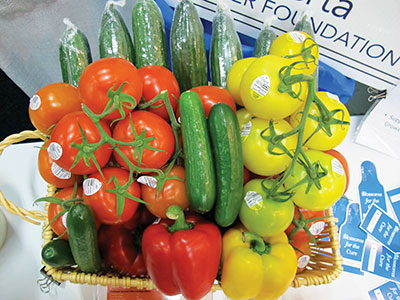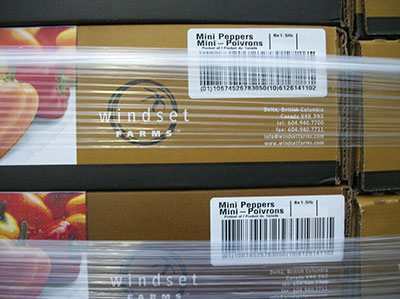
Traceability of all foods is very important for Canadian consumers these
days, and that’s why governments, retailers and food producers across
the country are taking action.
Traceability of all foods is very important for Canadian consumers these days, and that’s why governments, retailers and food producers across the country are taking action.
 |
|
“We currently have a massive overhaul of Canadian food safety regulations happening, and traceability is a part of that,” observes Jane Proctor, vice-president of policy and issue management Canadian Produce Marketing Association (CPMA).
The CPMA has been a part of traceability implementation in the sector since the beginning, and with two other Canadian groups and one U.S. group, created the Produce Traceability Initiative (PTI).
“What we hear from government is that consumers feel food safety and traceability are important,” Proctor explains.
“In other parts of the world, there have been outbreaks and some deaths from field-grown produce, and for that reason, we are all subject to the same expectations and food safety protocols that include effective traceability.”
Beyond what is being expected of food producers from government and consumers, Proctor notes that retailers also have traceability expectations. “From the regulatory, supply chain, consumer angles and more, traceability is a reality of doing business today.”
Traceability systems are quite efficient and effective.
“The overall good news is that the data and processes implemented to meet traceability requirements, if based on global standards as with PTI, will benefit your business on the whole, in all processes,” she says. “Better food safety and boosted efficiencies in the buy-sell process come when everything is electronic and information-sharing is more efficient.”
Proctor is one of many experts advising growers to start working on their traceability strategy now, if they haven’t already started.
“Do not wait until it’s a regulatory requirement as there is a great deal of internal work which needs to occur within an organization before traceability is fully in place,” she explains.
To assist industry members, CPMA has been developing a traceability learning module, which will be a key resource for growers.
PUTTING TRACEABILITY SYSTEMS IN PLACE
Windset Farms in Delta, British Columbia, is one of many Canadian greenhouse operations where company leaders and staff have put in considerable time and effort to get their traceability system up and running.
Windset food safety manager Suby Kaur says all items under the Windset name are fully traceable down to the case level, and that Windset Canada has been PTI-compliant since March 2011.
“Traceability is very important for producers and consumers as product is being imported and exported more than ever before,” he notes. “Being able to trace, at the case level, everything that was produced to a particular crop/greenhouse allows us to protect our brand and our customers efficiently, in the event of a recall.”
Kaur says the system scans and tracks cartons and pallets as they are received, assembled, stored and shipped using bar code scanners. “There is now the ability to trace their product all the way from the greenhouse row through to shipping their product out to retail and food service.”
Growers can purchase commercial software along with label printers and barcode scanners. The software involves inputting and handling information in the areas of receiving, production, assembly and shipping.
Kaur notes that the overall implementation of their traceability program currently takes about three to four hours per day of labour at Windset, but that they expect that the system will soon result in the creation of improved records for management decisions and tracking in a more efficient time frame.
TECHNOLOGY AND IMPLEMENTATION
Proctor says in the federal consultations currently underway to overhaul of Canadian food safety regulations, the Canadian Food Inspection Agency (CFIA) is sharing the expectation that traceability data be easily accessible, electronic and unencrypted data. In other words, information should be able to be received by the proper authorities well within 24 hours to deal with any situation that has arisen.
 |
|
| Bar code scanners are used in many traceability programs.
|
PTI has worked out an effective structure for information capture, one that does not impede business productivity, and that supports the CFIA expectation. Proctor adds that there are also many third party providers developing data capture strategies, and that currently, “barcodes remain the main means for carrying the data along the supply chain via both case and pallet labels.”
Proctor sees barcodes as stable for the foreseeable future, but notes that labelling is evolving along with other technologies and implementation strategies.
She says some provinces have traceability initiatives underway, using implementation-oriented funding available under the federal Growing Forward 2 program, and that harmonizing provincial traceability implementation is a priority.
If we look at what was being implemented in B.C. in 2012 for example, we have to look at the applications for funding under the province’s Traceability Adoption Program. In 2012, successful applicants (none applied that year from the greenhouse sector) were using software programs that integrate with distributor systems, along with bar code printers for labels on pallets and cases.
In terms of what has changed since then, Victor Martens, owner of VM Technical Services in Abbotsford (a company that delivers the B.C. Traceability Adoption Program) notes that new developments he’s seeing in traceability include the use of cloud databases, which can be accessed by producers, consumers and distributors.
He also lists the use of hand-held devices (smart phones and tablets) for data entry and scanning, as well as more traceability software tied in with Enterprise Resource Planning systems, more use of RFID tags, and more integration of production, packing and processing information.
UPDATING STANDARD OPERATING PROCEDURES
Kaur says tools such as voice recognition software, pallet tags and logistic labels are a great help. Windset has also updated standard operating procedures, and trained staff extensively on the importance and use of PTI and data integration.
In Proctor’s view, there is good news regarding the challenges of traceability for greenhouses in that it’s easier than it is for field produce operations.
“The packing is done in a cleaner and more controlled environment in a greenhouse which gives greater control over a key component of traceability – getting the right labels on the right cases,” she says.
“Still, with any system, you have to be disciplined and it’s going to take time to fully develop it. It’s a matter of finding out what all your buyers need, to make sure what you are doing meets everyone’s requirements.”
Treena Hein is a freelance writer in Ontario.
Print this page